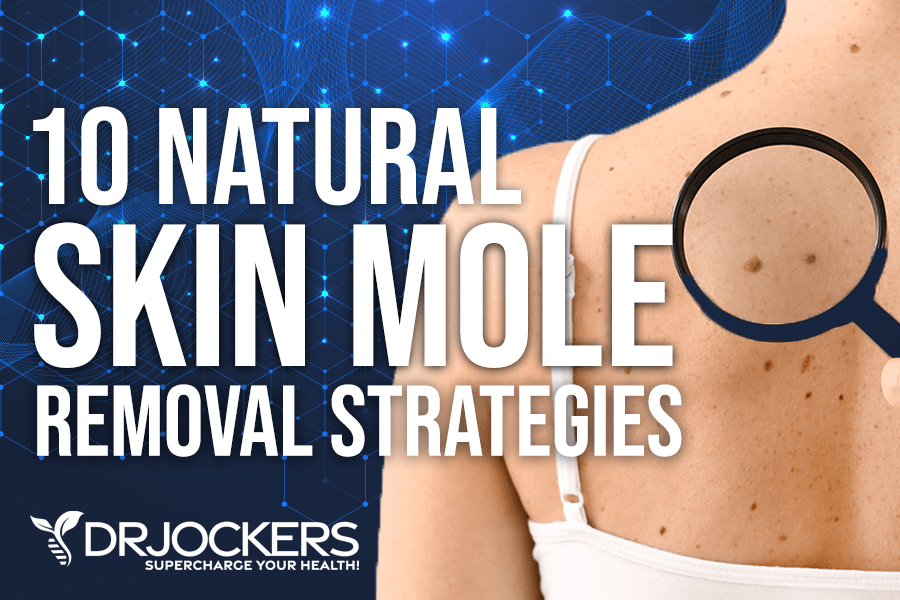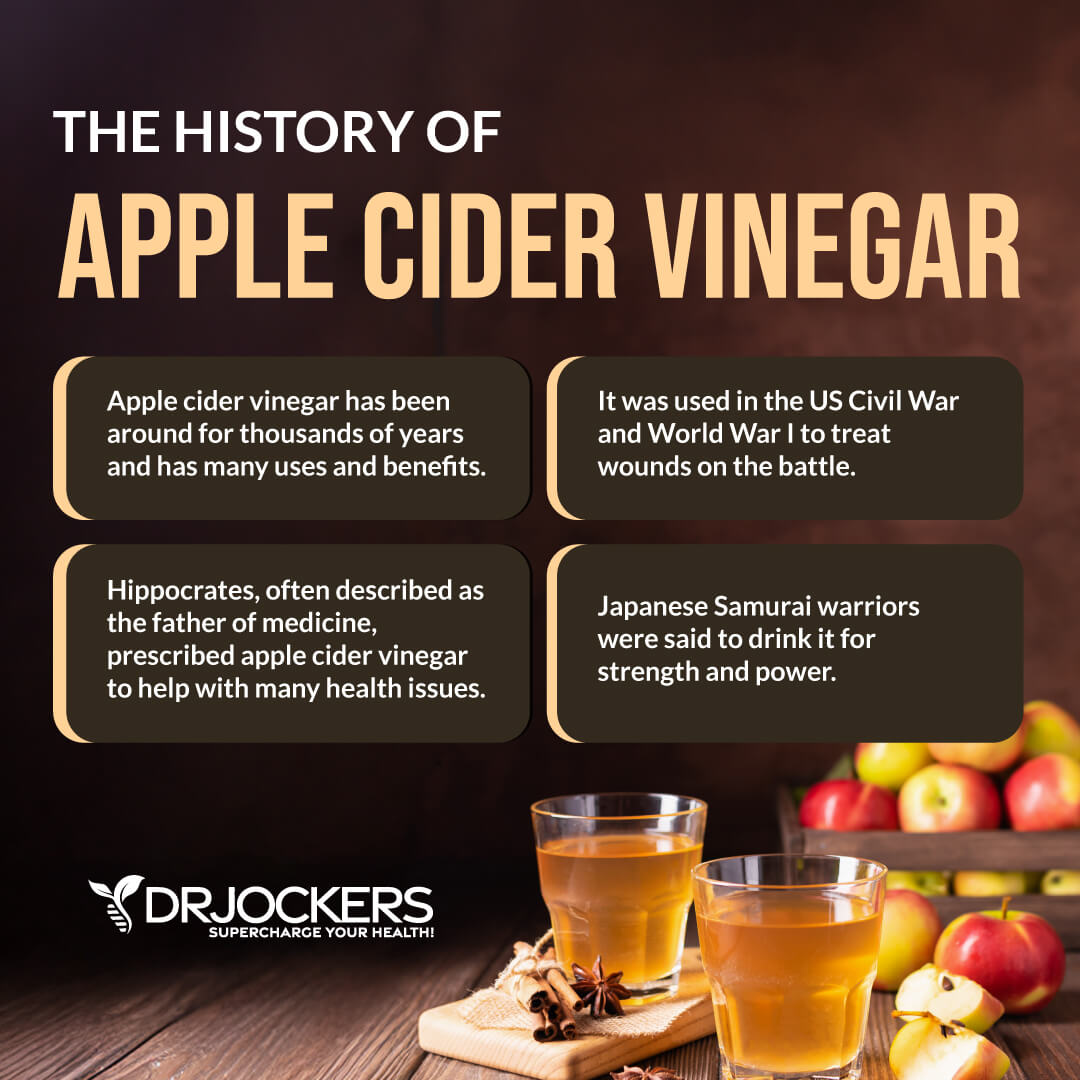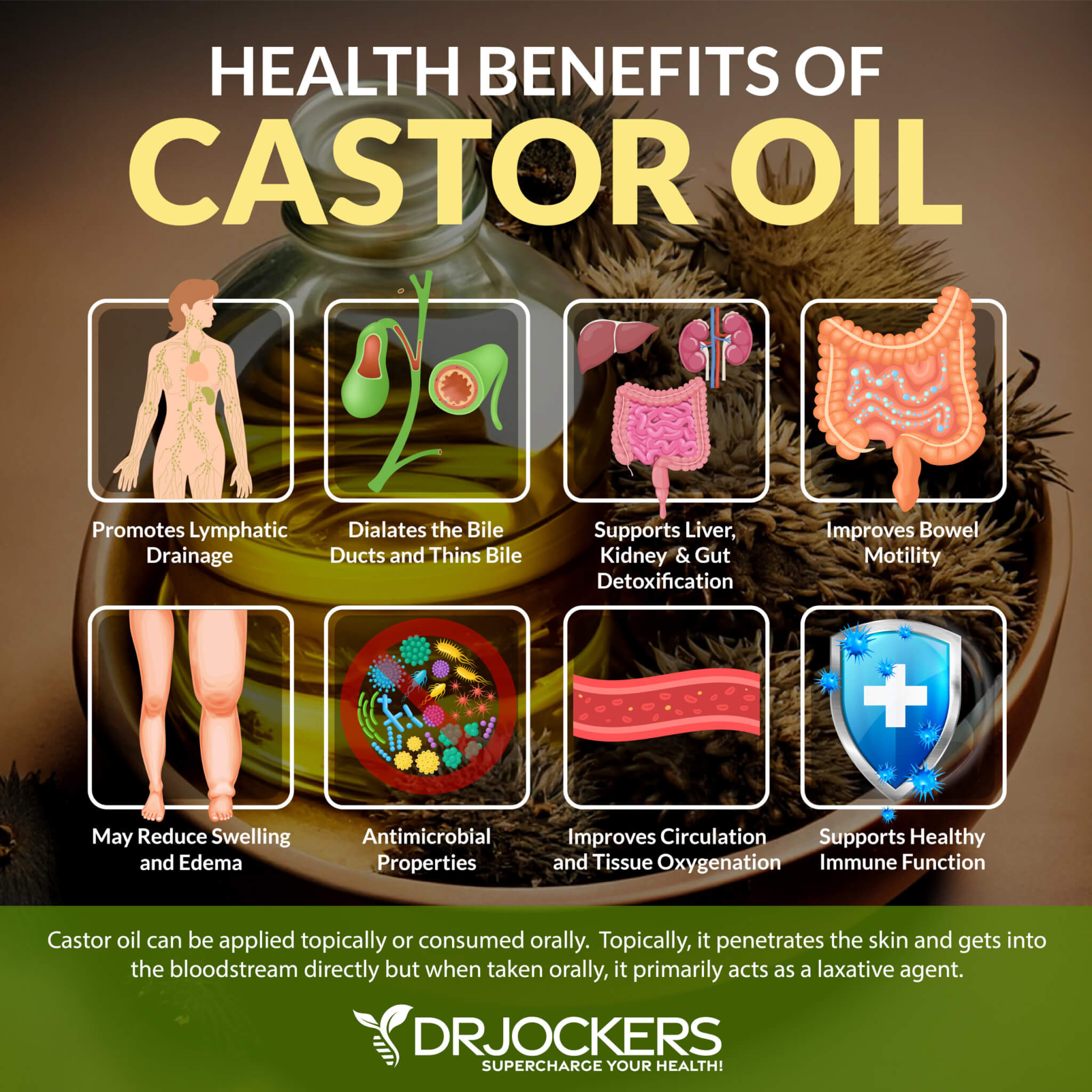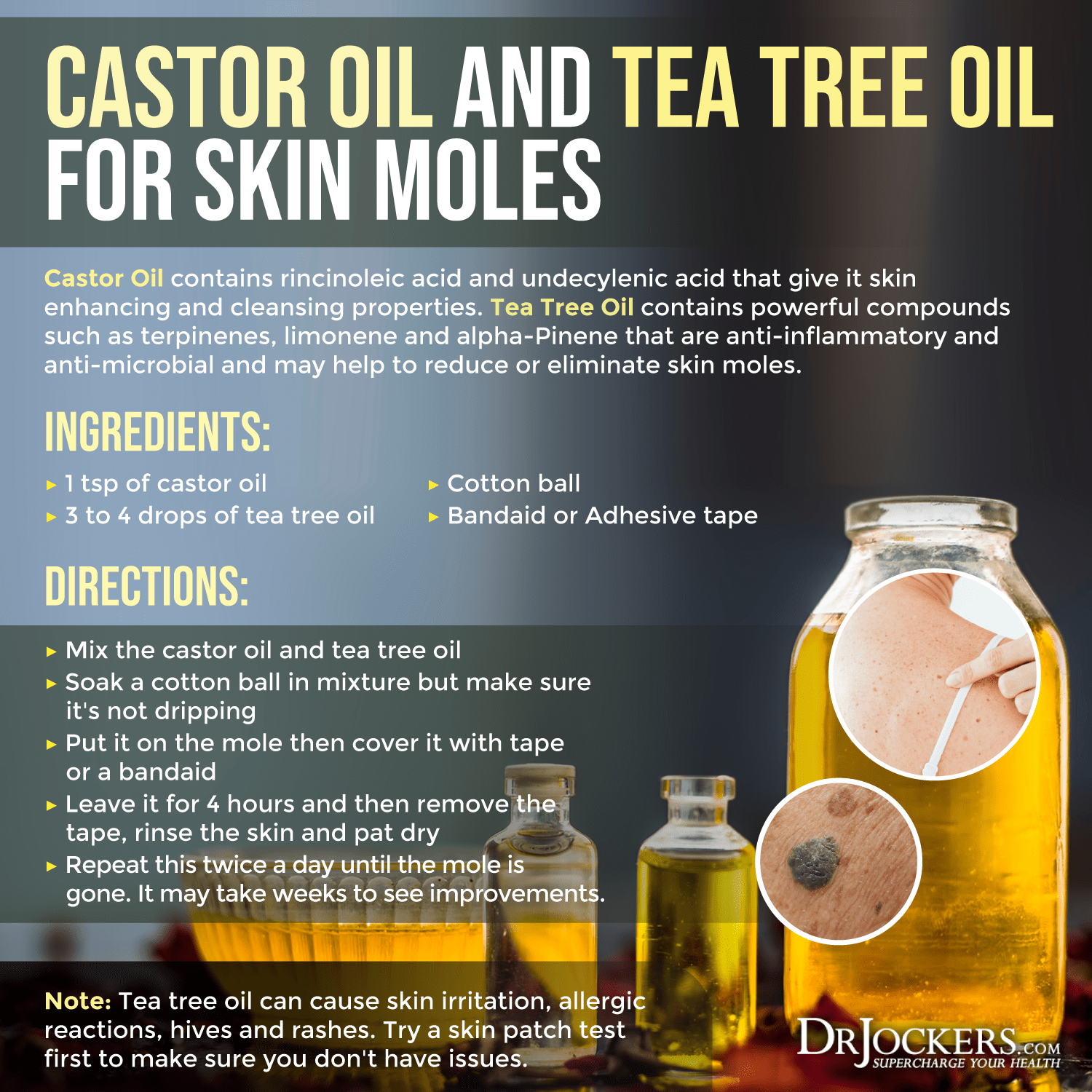 Skin Moles: Signs of Cancer and 10 Natural Removal Strategies
Skin Moles: Signs of Cancer and 10 Natural Removal Strategies
We don’t often think about our skin as an organ. Yet, it is the largest organ in your body. As with any organ, things can happen that can be alarming, though not always dangerous or harmful. Skin moles are like that. Most skin moles are harmless. However, some can be or can turn cancerous, so it’s important that you pay attention to them and note any changes or new moles.
In this article, you will learn what skin moles are. You will learn how skin moles develop. You will understand the difference between skin moles and skin cancer. I will go over conventional treatment options for skin moles. I will also offer some natural removal strategies you may try at home.

What are Skin Moles
Skin moles, in medical terms, are also called nevus or nevi. Skin moles are clusters of melanocytes that cause an elevated hyperpigmented spot on the skin. They are a growth on your skin that can occur anywhere on your skin or mucous membranes. Their color may be anywhere from natural skin tone, to brown, or black. Moles may appear alone or in groups (1).
Though most skin moles tend to appear in early childhood or before your 20th birthday, some may occur later. The average person may have between 10 and 40 moles by adulthood. However, this may depend on the specific person, their genetics, and also their race and ethnicity.
As you get older, your moles may naturally change. They may become raised, become lighter, or develop hairs. Some moles can disappear, as the average life cycle of the average mole is about 50 years. However, some moles don’t change at all and don’t disappear.
Types of moles (1):
- Atypical mole: Atypical moles are not melanoma but can look like it. Atypical moles tend to have an odd shape, have a mix of colors (e.g., a mix of tan, brown, pink, or red), and are larger than a pencil eraser. Though they may occur anywhere on your body, they most commonly occur on the trunk of the body and also on the neck, head, and scalp. Though they are not melanoma, they have a higher chance of turning into melanoma, so it’s important to pay attention to them. Your risk of developing melanoma is higher if you have a first-degree relative with melanoma, have had melanoma in the past, or have four or more atypical moles. People with familial atypical multiple mole melanoma (FAMMM) syndrome have over 50 moles, many of which are atypical and usually a blood-relative with present or past melanoma.
- Congenital mole: Congenital mole means that you have a mole that you were born with. About 1 in 100 people are born with a congenital mole. Congenital moles can have various sizes, anywhere from small to giant. They may increase in size as you grow.
- Spitz nevus: Spitz nevus is a mole that’s raised, dome-shaped, and usually pink. It may be red, brown, or black too. They tend to occur before age 20, though sometimes they may occur later. They can resemble melanoma very closely and may bleed.
- Acquired mole: Acquired moles develop after you are born. Most people have 10 to 40 acquired moles, though you may have more or less of them. If you have more than 50, your risks of developing melanoma are higher than if you have less.

How Do Skin Moles Develop
You may develop skin moles for a variety of reasons. As you know, some moles are present at birth, others develop later. Most develop during childhood or before age 20, but you may develop some later in life.
The reason why new moles develop later in adulthood is not clear. While some moles are or can become cancerous, many moles are benign (not cancerous and not harmful). There is much less research on benign skin moles than on melanoma. According to a 2015 review published in Pigment Cell and Melanoma Research, genetics may often play a role in the development of skin moles (2).
Researchers found that in 78 percent of benign acquired moles, there is a BRAF gene genetic mutation present. BRAF mutations can also be involved in melanoma. This means that these genetic mutations may be involved with the increased risk of benign skin moles turning cancerous through molecular processes and skin inflammation. Ultraviolet light (UV) and DNA damage may play a role in genetic damage that can lead to melanoma.
A 2017 review published in the Journal of the American Academy of Dermatology has found that 70.9 percent of melanoma cases come from new moles (2). A variety of factors may increase your risk of developing a new mole in adulthood.
Some of these factors may include having a family history of atypical moles, genetic mutations, aging, sunburn, tanning bed use, too much sun exposure, having fair skin, having red or light hair, taking medications that suppress your immune system, and reactions to certain medications, including hormones, antibiotics, or antidepressants.
Regularly checking your skin for new skin moles and getting them checked out is very important to prevent melanoma and catching it early. Remember, catching melanoma or other skin cancer early can increase your chances of full recovery.

Skin Moles or Skin Cancer
Most skin moles are benign and not dangerous. Some moles, however, are cancerous or can turn cancerous. New and changing bumps, growth, lesions, moles, or rough patches on your skin are usually the first and main symptoms of melanoma. Not all new moles are cancerous, and not all skin cancer comes from new moles.
According to the Skin Cancer Foundation, about 20 to 30 percent of melanomas develop from existing skin moles, and 70 to 80 percent develop from new moles on previously normal skin (4). So how to differentiate between skin moles and skin cancer?
Normal moles are usually round or oval-shaped with well-defined edges, flat or dome-like, smaller than ¼ inch in diameter, tan, brown, dark brown, or flesh-colored. Skin cancer usually looks atypical.
To differentiate between normal skin moles and cancerous moles, you can use the ABCDE test at home:
- A for Asymmetry: Most melanomas are not symmetrical. This means it is not the same on both sides. If it was folded in half, the two halves would not match.
- B for Border: Melanoma borders tend to be uneven and may have scalloped or notched edges rather than smooth, even borders.
- C for Color: Multiple colors, such as different shades of brown, tan, or black, are a warning sign for melanoma. Also, look for darkening, loss of color, spreading color, or other changes in the color of the mole.
- D for Diameter or Dark: A mole more than ¼ inch in diameter (the size of a pencil eraser) is a warning sign.
- E for Evolving: A mole looks different from others or is changing in shape, size, or color. A new symptom in the mole, such as bleeding, itching, or crusting, may be a warning sign of melanoma.
One more thing to watch out for is the “ugly duckling”. Melanomas typically stand out like ugly ducklings in comparison to most moles on the body. Melanomas can also develop in areas of your body that have little or no exposure to the sun, such as the spaces between your toes and on your palms or soles, on the scalp, under a nail, and in the eye, mouth, digestive tract, urinary tract, or vagina.
If you notice anything unusual, see anything listed on the ABCDE test, find an “ugly duckling”, or see or feel anything concerning otherwise, visit a dermatologist as soon as possible. Diagnosing melanoma as early as possible is critical for treatment and recovery. And if it all turns out fine, you will have peace of mind. Yearly skin checks, especially if you have a lot of skin moles or risk factors for skin cancer, may be a good idea.

Conventional Treatment Options
As a conventional treatment option, your dermatologist can usually remove a skin mole easily during a regular doctor’s visit. These are the most common procedures used for removing skin moles:
- Freezing: This method involves using a small amount of liquid nitrogen to remove any non-cancerous skin moles or other skin problems, like skin tags or skin warts.
- Burning: This method involves an electric current or laser that can burn off the upper layer of a skin mole. One session may not be enough, and you may need more to completely remove a non-cancerous skin mole.
- Shaving; This method allows your doctor to shave off a non-cancerous skin mole with a surgical blade from your skin’s surface.
- Excision: This method also uses a surgical blade but goes deeper than just removing the moles from the surface. This method is usually used for cancerous moles. It requires stitching after the procedure.
After the procedure, your doctor can send the removed skin mole to be checked for skin cancer.

Natural Removal Strategies at Home
There are several natural removal strategies you can try at home to remove non-cancerous skin moles. I must note that these strategies may or may not work, but they won’t cause further harm. However, it is always advisable to have the mole looked at by a professional to rule out melanoma or other issues first before removing a mole at home.
To avoid allergic reactions and sensitivities, do a patch test first before trying any of these strategies. Commit to one strategy instead of combining everything all at once. If one doesn’t work for you or causes skin irritation, you may try another strategy. With that said, here are some natural removes strategies you can try at home:

Apple Cider Vinegar
Apple cider vinegar is fermented apple juice with all kinds of benefits, including for skin health. A 2018 study published in Science Reports has found that apple cider vinegar may have antimicrobial and anti-inflammatory properties on the skin (5).
Being an acidic liquid, it can help to burn off a mole. It will make it scab and fall off. However, because apple cider vinegar is acidic, it can lead to skin sensitivity. If you have sensitive skin, be careful when using it for the first time.
To remove a skin mole with apple cider vinegar, all you need is some high-quality raw apple cider vinegar, cotton balls, and bandaids.
Ingredients:
- Apple cider vinegar
- Cotton balls
- Bandaids
Directions:
- First, dip half of the cotton ball into the apple cider vinegar.
- Squeeze out an extra so it’s not dripping.
- Put this apple cider vinegar part of the cotton ball on the mole and cover it with a bandaid.
- Leave it for up to 8 hours, then remove it.
- If you have sensitive skin, you may want to start out slowly. Start with 1 hour first and see how you react.
- Continue using this method every day until the mole scabs and falls off.

Castor Oil
Castor oil is an oil made from castor bean seeds. It is used in the alternative and natural health world for a variety of remedies because of its antibacterial, antiviral, and antifungal properties. According to a 2012 study published in Food Chemistry, castor oil may offer antioxidant, antifungal, and antimicrobial benefits (6).
You might’ve heard about castor oil packs for the liver, kidneys, and digestion. Castor oil may also be beneficial for your skin, skin hydration, acne, stretch marks, removing scars, and removing skin moles.
You may use castor oil for skin moles in a variety of ways. Always clean the skin before using any of these methods. Here are the castor oil strategies for skin moles:

Castor Oil and Baking Soda for Skin Moles
Ingredients:
- 2 to 3 drops of castor oil
- ½ tsp baking soda
- Bandaids
Directions:
- Mix the castor oil and the baking soda into a sticky paste.
- Cover the skin mole with the paste.
- Cover it with a bandaid and leave it overnight.
- Repeat this every other day until the mole falls off. It can take a few weeks.
Castor Oil and Garlic for Skin Moles
Ingredients:
- 2 to 3 drops of castor oil
- ½ tsp of garlic paste or garlic powder
Directions:
- Mix the castor oil and the garlic into a paste.
- Put it on the skin mole and leave it on for a few hours.
- Wash it off with water, then pat dry.
- Repeat this twice a day until the mole is gone. It may take weeks to see improvements.
- Note: This remedy is not appropriate if you are allergic to garlic.

Castor Oil and Honey for Skin Moles
Ingredients:
- 2 to 3 drops of castor oil
- 1 tsp of raw honey
- ½ tsp of flaxseed powder
- Bandaid
Directions:
- Mix the castor oil, honey, and flaxseed into a paste.
- Apply it onto the mole.
- Cover it with a bandaid and leave it for a few hours.
- Remove the bandaid. Wash off the area and pat dry.
- Apply this twice a day until you see results, which may take 7 to 10 days.
Castor Oil and Tea Tree Oil for Skin Moles
Ingredients:
- 1 tsp of castor oil
- 3 to 4 drops of tea tree oil
- Cotton ball
- Bandaid or adhesive tape
Directions:
- Mix the castor oil and tea tree oil.
- Soak a cotton ball but make sure it’s not dripping.
- Put it on the mole then cover it with tape or a bandaid.
- Leave it for up to 4 hours.
- Remove the tape. Rinse the skin. Pat dry.
- Repeat once or twice a day until you see results. It may take a month for the mole to fall off.
- Note: Tea tree oil can cause skin irritation, allergic reactions, hives, and rashes. Try a skin patch test first to make sure you don’t have issues.

Frankincense Essential Oil
Frankincense essential oil has been used throughout history by countless cultures, including the early Egyptians, the ancient Greeks, and teachings in Chinese medicine for all kinds of ailments, including respiratory illness, skin conditions, and hemlock poisoning.
According to a 2012 study published in the Letters of Applied Microbiology, Frankincense essential oil may offer antimicrobial benefits, which may benefit skin health too (7). Frankincense essential oil may help to remove skin moles. Here is how to use it:
Ingredients:
- ½ to 1 cup of baking soda
- 3 drops of Frankincense essential oil
- 6 drops of lavender essential oil
- ½ to 1 cup of Himalayan sea salt
Directions:
- Add these ingredients into a hot bath.
- Take a hot bath daily in this water.
You may also apply frankincense essential oil directly on a skin mole. Use these methods twice a day for two weeks. Over time, it may make the skin mole to blacken and then fall off. You may use frankincense essential oil for a few days after the mole has fallen off to prevent any scarring.

Banana Peels
You may also try banana peels for removing skin moles. Banana peels are loaded with enzymes and acids that may help to remove skin moles. According to a 2016 study published in Angewandte Chemie, old banana peels contain an enzyme called tyrosinase that your skin contains, too (8). They may also act as skin moisturizers to reduce the risk of dryness and skin damage. Here is how to use it.
Ingredients:
- Banana peel
- Bandaids
Directions:
- Grate some banana peel.
- Put it over the skin mole.
- Cover it with a bandaid or tape.
- Leave it overnight.
- Repeat until the mole falls off.

Hydrogen Peroxide
Hydrogen peroxide is another substance often used for skin health. According to a 2022 study published in Clinical, Cosmetic, and Investigational Dermatology, hydrogen peroxide may help to improve skin microbiome and enhance skin recovery (9). It may also help to remove skin moles.
Ingredients:
- Hydrogen peroxide
- Make sure to talk to your pharmacist and make sure you are buying a hydrogen peroxide safe for your skin.
Directions:
- Apply hydrogen peroxide on your skin 3 to 4 times a day until the mole is gone.

Aloe Vera
Aloe vera is another simple and natural remedy for skin health. According to a 2008 review published in the Indian Journal of Dermatology, aloe vera may help to promote skin health (10). It may help with sunburn, wounds, and irritation. It may also help to remove skin moles.
Ingredients:
- Aloe vera, plant or a natural aloe vera gel product
Directions:
- Apply the aloe vera on the mole.
- Use this daily until the mole is gone.
- Note: make sure to do a skin patch test first to spot potential allergies. This is a good idea for any other strategies listed in this article.

Iodine
Iodine may be another great natural remedy for skin moles. Iodine offers antimicrobial benefits. It may help to repair skin and heal wounds and scars. According to a 2017 study published in Free Radical Biology and Medicine, iodine may help to reduce inflammation and immune reactions of the skin (11). It may help skin moles to flake off over several weeks.
Ingredients:
- Iodine, I recommend this Detaxodine iodine product
Directions:
- Make sure your skin is not broken.
- Apply iodine on the mole at night.
- Use this every night until the mole is gone.
Final Thoughts
Skin moles are common. Most people have 10 to 40 of them on their bodies. Most skin moles are harmless. However, since some can turn or are cancerous, it’s important that you regularly examine your skin, looking for changes and new moles.
If you have non-cancerous moles that you want to remove for any reason, you may try the natural removal strategies I shared in this article. While these remedies may or may not work, they are not harmful, and some may be beneficial for your skin health.
If you want to work with a functional health coach, I recommend this article with tips on how to find a great coach. On our website, we offer long-distance functional health coaching programs. For further support with your health goals, just reach out—our fantastic coaches are here to support your journey.
Inflammation Crushing Ebundle
The Inflammation Crushing Ebundle is designed to help you improve your brain, liver, immune system and discover the healing strategies, foods and recipes to burn fat, reduce inflammation and Thrive in Life!
As a doctor of natural medicine, I have spent the past 20 years studying the best healing strategies and worked with hundreds of coaching clients, helping them overcome chronic health conditions and optimize their overall health.
In our Inflammation Crushing Ebundle, I have put together my very best strategies to reduce inflammation and optimize your healing potential. Take a look at what you will get inside these valuable guides below!
Sources in This Article Include:
1. Moles. AAD. Link Here
2. Roh MR, Eliades P, Gupta S, Tsao H. Genetics of melanocytic nevi. Pigment Cell Melanoma Res. 2015 Nov;28(6):661-72. doi: 10.1111/pcmr.12412. PMID: 26300491
3. Pampena R, Kyrgidis A, Lallas A, Moscarella E, Argenziano G, Longo C. A meta-analysis of nevus-associated melanoma: Prevalence and practical implications. J Am Acad Dermatol. 2017 Nov;77(5):938-945.e4. doi: 10.1016/j.jaad.2017.06.149. Epub 2017 Aug 29. PMID: 28864306
4. Melanoma warning signs. Link Here
5. Yagnik D, Serafin V, J Shah A. Antimicrobial activity of apple cider vinegar against Escherichia coli, Staphylococcus aureus and Candida albicans; downregulating cytokine and microbial protein expression. Sci Rep. 2018 Jan 29;8(1):1732. doi: 10.1038/s41598-017-18618-x. PMID: 29379012
6. Reddy KK, Ravinder T, Kanjilal S. Synthesis and evaluation of antioxidant and antifungal activities of novel ricinoleate-based lipoconjugates of phenolic acids. Food Chem. 2012 Oct 15;134(4):2201-7. doi: 10.1016/j.foodchem.2012.04.046. Epub 2012 Apr 17. PMID: 23442675
7. de Rapper S, Van Vuuren SF, Kamatou GP, Viljoen AM, Dagne E. The additive and synergistic antimicrobial effects of select frankincense and myrrh oils–a combination from the pharaonic pharmacopoeia. Lett Appl Microbiol. 2012 Apr;54(4):352-8. doi: 10.1111/j.1472-765X.2012.03216.x. Epub 2012 Feb 20. PMID: 22288378
8. Monitoring Tyrosinase Expression in Non-metastatic and Metastatic Melanoma Tissues by Scanning Electrochemical Microscopy. Link Here
9. Gruber JV, Riemer J. Examining Skin Recovery After a 3% Aqueous Hydrogen Peroxide (H2O2) Treatment Using ATP Biofluorescence. Clin Cosmet Investig Dermatol. 2022 May 24;15:929-937. doi: 10.2147/CCID.S363723. PMID: 35637748
10. Surjushe A, Vasani R, Saple DG. Aloe vera: a short review. Indian J Dermatol. 2008;53(4):163-6. doi: 10.4103/0019-5154.44785. PMID: 19882025
11. Ben-Yehuda Greenwald M, Frušić-Zlotkin M, Soroka Y, Ben-Sasson S, Bianco-Peled H, Kohen R. A novel role of topical iodine in skin: Activation of the Nrf2 pathway. Free Radic Biol Med. 2017 Mar;104:238-248. doi: 10.1016/j.freeradbiomed.2017.01.011. Epub 2017 Jan 12. PMID: 28088623





Thank you for all the work that you do and share. It is a blessing. It is healing. I am grateful for your expertise and warm heart.
Blessings to you, your beautiful family and your team.
Warm regards from beautiful Puerto Vallarta, Mexico.
P.S. Do visit my slice of paradise with your loved ones.
Thank you!
Dr. Jockers I am always so greatful that you are so thorough and understandable when bringing up your health articles. Your diagrams/illustrations along with descriptions is very helpful.
I am 73, noticed several small flat brown moles that developed over the last 5 yrs. on upper stomach, below breasts. I did ask a dermatologist who glanced at them and wasn’t concerned. I had read that this can be a sign of a higher than normal fasting insulin number (mine is around 8 to 12 – should be below 5 at least).
Why did these appear and no, I don’t wear a bikini and live in the Pacific NW?
Yes it is possible that it may be due to the higher insulin levels.